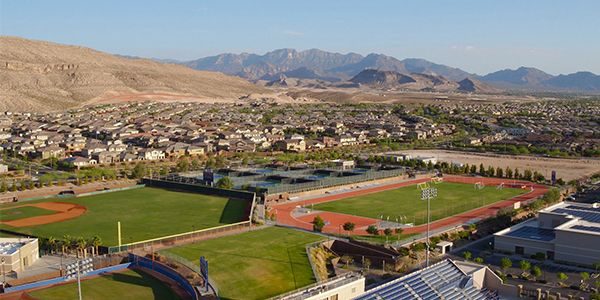
Red Rock Canyon National Conservation Area: Protected, forever.
The American business tycoon, Howard Robard Hughes Jr. privately purchased 30,000 acres of land west of Las Vegas, that is now Summerlin, in 1952. In the early 1980s, Summa Corporation (predecessor to The Howard Hughes Corporation) realized the development potential of the land. The community was named Summerlin for Hughes’ paternal grandmother, Jean Amelia Summerlin.
As the decades unfolded and the master planned community of Summerlin evolved many steps were forged to protect the acres of natural beauty on the far west lands of the development which is now Red Rock Canyon National Conservation Area.
In 1988, The Howard Hughes Corporation (Hughes) gave up more than 5,000 acres in a land exchange with the Bureau of Land Management (BLM) to create a buffer zone that forever protects Red Rock Canyon and the scenic loop road experience. In 2001, HHC donated $30,000 to the BLM for new trail marker signage throughout the Conservation Area.
In 2002, Hughes enacted a second federal land exchange with the BLM. This exchange preserved an additional 1,100 acres along Summerlin’s western border, adding it into the Red Rock Canyon National Conservation Area to maintain the view-shed and protect the lower slopes of the mountains from development.
Additionally, Hughes has long worked with federal and state governments, as well as Las Vegas Paiute tribal leaders and the archaeological community, to protect historic American Indian rock art etched into rock faces along the western edge of the Las Vegas Valley. Hughes is also currently working with the appropriate parties to create an interpretive trail system that will tell the story of our valley’s original residents, the Las Vegas Paiutes, preserving their legacy for many decades to come.

We know H2O.
Summerlin began incorporating desert landscape into its common areas in the late 1990s as one of the Las Vegas valley’s earliest adopters of the concept.
In 2003, in partnership with Southern Nevada Water Authority (SNWA), Summerlin became the area’s first community to implement strict Water Smart conservation guidelines on a community-wide basis. This included restricting grass for new home construction – disallowing it in front yards and limiting it to 50 percent of back and side yards. Considered a progressive stance at the time, Summerlin’s commitment to water conservation was widely lauded, especially given the community’s size and volume of new home development that resulted in significant water savings.
Today, the community continues to remove non-functional grass that serves only a decorative purpose, replacing grass with desert-friendly plant materials, including salvaged native plant revegetation and drip irrigation. This innovative new landscaping technique, evident in the village of Stonebridge, The Summit and throughout Summerlin West, saves even more water than desert landscaping, with some re-veg landscapes eventually requiring no irrigation at all.
HHC executives served on SNWA’s Water Conservation Coalition for years, encouraging water conservation not only in Summerlin, but valley-wide. Summerlin continues to be a champion of water conservation in both new commercial and residential development, removing hundreds of acres of grass throughout common areas to save millions of gallons of water annually.

We know how to conserve H2O.
Las Vegas has a unique and highly commendable water reuse recycling program for indoor water use. This is an excerpt from the Southern Nevada Water Authority Website and for further information on water conservation efforts please visit SNWA.com.
Return-flow credits
“When you take a shower or wash your laundry, the unused water flows into the sewer system. This sewer water travels to a wastewater treatment facility, where it is treated.
The highly-treated wastewater is returned to the Colorado River via the Las Vegas Wash, which flows into Lake Mead. The water returned to the lake earns us return-flow credits.
Every gallon of water that is returned to the Colorado River through return-flow credits allows Southern Nevada to take another gallon out, which stretches our limited water supply.
With return-flow credits, Nevada can withdraw more than 300,000 acre-feet per year, so long as there are enough flows returned to the river each year that our consumptive use is no greater than 300,000 acre-feet of water per year.” (SNWA.com March 2023)

Breathe easier.
In the mid-1990s, HHC executives served on a valley-wide development industry coalition that drafted the nation’s toughest self-imposed rules on dust control and air quality
Clean air matters:
– Summerlin was the first community in Southern Nevada to incorporate roundabouts into its roadway system, a concept that allowed for better traffic flow and reduced pollution through the elimination of idling at lights and stop signs.
– The Summerlin Trail system provides safe routes where many kids can walk to school safely without having to cross streets, reducing the number of cars on the road both before and after school.
– Downtown Summerlin offers 318 stalls for low emission vehicles, and four stalls with electric vehicle charging devices.

Nature, as it was meant to be.
The preservation of our stunning desert backdrop has always been an integral part of our vision, with natural landscapes and topography integrated into the community wherever possible. HHC works closely with federal and state governments, tribal leaders, and the archaeological community to protect historic American Indian rock art along the western edge of the Las Vegas Valley. The community’s 200-plus miles of trails connect neighborhoods and villages, and encourage outdoor recreation and neighborhood socialization. These trails include 10 miles of trail along the completed 215 Beltway, and will eventually connect directly to Red Rock Canyon National Conservation Area.
TPC Summerlin and TPC Las Vegas golf courses are Certified Audubon Cooperative Sanctuary golf courses, dedicated to conserving water and preserving all wildlife habitats. In 1998, HHC played a leadership role in the establishment of a development fee to fund a widely acclaimed multi-species habitat program here in Southern Nevada.
In 2008, HHC received the American Trails Developer Award from American Trails, a non-profit organization dedicated to trail interests. The award recognizes well-designed multi-use trail systems, and this was the first time a private developer was ever honored.

Over 200+ miles of trails in Summerlin.
Street-side Trails
Street-side trails are the backbone of the Summerlin Trail System. Always landscaped on both sides and set several feet off the road, street-side trails vary in width from five to eight feet and are designed to serve both serious and casual users.
Village Trails
Village trails are often located in natural arroyos or man-made open space corridors within a village in off-street areas. They are grade separated from busy streets and therefore provide respite from noise and traffic, and serve long-distance walkers, runners, cyclist, skaters and Summerlin’s young scholars traveling to and from school. These trails open up natural view corridors for all to enjoy.
Regional Trails
Regional trails are planned as part of the proposed 2,000-plus-mile, valley-wide trail system that will eventually connect the Summerlin Trail System with trails throughout the Las Vegas valley and Red Rock Canyon National Conservation Area. Proposed trails are located along the eight-mile 215 beltway and along flood control channels in Summerlin and are designed for multiple non-motorized uses. Regional trails are being constructed as a public/private partnership of Clark County and the City of Las Vegas in cooperation with The Howard Hughes Corporation.
Natural Trails
Natural trails will be located along Summerlin’s western border. These trails will connect the Summerlin Trail System with regional trails located in the nearly 200,000 -acre Red Rock Canyon National Conservation Area. Natural Trails will be located in low density areas and are intended for use by outdoor enthusiasts and hiking buffs.
Trails Map
Desert Clean-ups.
The Howard Hughes Corporation has organized and hosted many desert clean-ups in and around Summerlin, in partnership with both private companies and public agencies. Through these efforts, hundreds of tons of illegally dumped trash have been removed from the area. The company also encourages, welcomes and supports private groups, such as Eagle Scout projects, to organize smaller clean-ups in and around the community.

Leaders in Energy and Environmental Design.
As we build the communities of tomorrow, Summerlin and The Howard Hughes Corporation are committed to the environment – and reducing our environmental impact. Earth, and its resources, is our shared home. We believe in being good neighbors, but we also believe a commitment to Environmental, Social, and Governance issues is good business.
The Howard Hughes Corporation is committed to setting sustainable 10-year performance targets that are reviewed as industry standards evolve. Big impacts start with simple steps and we continue to stay informed, evolve our plan and continue to focus on our environmental stewardship.
- 24.5 percent reduction in energy consumption to optimize energy performance.
- 40 percent reduction in water use for enhanced water efficiency.
Downtown Summerlin North Retail – 2016 LEED Silver-certified
Downtown Summerlin South Retail – 2016 LEED Silver-certified
One Summerlin office building – 2016 LEED Silver-certified
Two Summerlin office building- 2018 LEED Silver-certified
1700 Pavilion office building – 2023 LEED Silver-certified
Tanager Echo – upon completion, this project will apply to become LEED Silver-certified
Summerlin South Office building – upon completion, this project will apply to become LEED Silver-certified

Growing smarter.
By their very nature, master-planned communities employ a variety of planning tactics to ensure smart growth and development in a thoughtful and more organized fashion. As Summerlin continues to evolve, the community is adding higher density urban areas throughout Downtown Summerlin and in areas of Summerlin West to give homebuyers even more options. In the Downtown Summerlin area, plans call for numerous multi-family residential options – including apartments, townhomes, and condominiums– to provide a true, more sustainable urban living experience.

Blossoming Biodiversity.
Summerlin evolves into a vibrant habitat for butterflies, bees, and insects, providing residents a unique educational experience. Intentional initiatives boost biodiversity, enhancing natural beauty and offering a valuable educational resource. Thoughtful landscaping and sustainable practices showcase Summerlin’s commitment to eco-friendly urban living and environmental awareness. Visit our pollinator garden at Downtown Summerlin, located under The Pavilion next to Banana Republic.
Learn More
Growing education.
Summerlin is a proud sponsor of Garden Farms in Summerlin schools. Southern Nevada’s school gardens gain traction, fostering educational opportunities. The article explores the growing trend, highlighting the positive impact on the community. With increased interest, these gardens contribute to a hands-on learning experience for students. The initiative reflects a commitment to holistic education and community engagement.
Learn More












